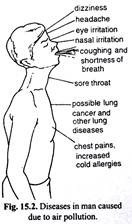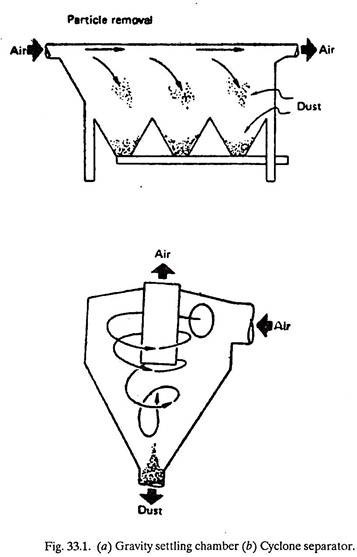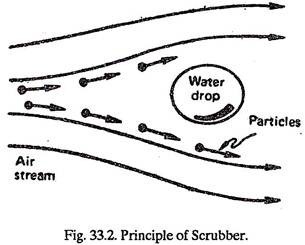The below mentioned article will help you prepare a science fair project on Air Pollution:- 1. Meaning of Air Pollution 2. Sources of Air Pollution 3. Nature of Air-Pollutants 4. Effects 5. Source Testing and Monitoring Air Quality 6. Devices to Control Air Pollution.
Contents:
- Science Fair Project on the Meaning of Air Pollution
- Science Fair Project on the Sources of Air Pollution
- Science Fair Project on the Nature of Air-Pollutants
- Science Fair Project on the Effects of Air Pollution
- Science Fair Project on the Source Testing and Monitoring Air Quality
- Science Fair Project on the Devices to Control Air Pollution
Science Fair Project # 1. Meaning of Air Pollution:
Air pollution may be defined as any gaseous, liquid or solid material suspended in the air which creates an undesirable effect. Air pollution is injurious both to life and property. Polluted air is present over almost every industrialized community. Much of the blame for the contaminated atmosphere can be directed toward automotive exhaust but industrial wastes are also big contributors.
Factories and electric-power generating plants emit sulphur dioxide and fly ash and microscopic pieces of metal or metal oxides. Air pollution is growing at a rate that alarms experts throughout the world and it will continue to grow despite measures being taken to alleviate it. Only the most drastic steps can reverse the present trend.
Science Fair Project # 2. Sources of Air Pollution:
(i) Increase in Population:
We are worried about our fast increasing population. It is believed that the present world population is likely to be doubled by the year 2000 reaching about six billion If this rate remains the same then the population would be doubled after every 35 years.
ADVERTISEMENTS:
The increase in population has resulted several serious problems including the worsening of the condition of environment. An estimate suggests that man alone has dumped 36,00,00,00,000 tons of carbon dioxide in the atmosphere.
If its concentration goes on increasing in the atmosphere, in addition to increase in atmospheric temperature it also pollutes the environment making it unsuitable for animal life.
(ii) Deforestation:
Since, plants purify the air by taking in carbon dioxide for their use and liberating oxygen which is used up by animals during respiratory activity liberating carbon dioxide used by the plants, hence, plants maintain a balance of these gases in nature.
ADVERTISEMENTS:
Deforestation, i.e., cutting of plants, trees and cleaning of the jungles and forests indiscriminately by man for his own need has disturbed the balance referred to. This has caused in an increase in carbon dioxide and decrease in oxygen concentration in the atmosphere.
(iii) Burning of Fossil Fuels and Fibres:
Wood, charcoal and fossil fuels are the conventional sources of energy. Burning of these sources causes air pollution. We see smoke coming out from every house every morning and evening. In fact, the by-products of burning are poisonous gases like carbon dioxide, carbon monoxide, sulphur dioxide, etc.
The kind, quality and concentration of these gases depend on the type of fuel being used. In the surroundings of factories, the concentration of sulphur dioxide in air is much higher. Sometimes, sulphur dioxide (SO2) mixes in the air with small particles of metals near the factories and gets oxidised into sulphur trioxide (SO3).
These gases are harmful and they react with water to form sulphuric acid (H2SO4) or sulphurous acid (H2SO3) and come down to the earth with rain water; it is called acid rain or acid precipitation. Thus, various poisonous gases coming out from the burning of fossil fuels and fibres, pollute the air making it foul or unfit for breathing.
(iv) Emissions from Vehicles:
ADVERTISEMENTS:
Nearly 80 per cent of total air pollution is caused by automobile, locomotives, aircrafts, exhausts, i.e., emissions from vehicles in cities. These vehicles release poisonous fumes by incomplete combustion of petrol and diesel which react with oxides of nitrogen in presence of sunlight in atmosphere to form photochemical smog; it is very toxic.
The important pollutants released from vehicles are carbon monoxide—77.2 per cent, nitrogen oxide— 7.7 per cent and hydrocarbons—13.7 per cent; in addition it also contains leaded gas and particulate lead.
In a survey conducted at Kolkata, it was estimated that carbon monoxide concentration of 35 ppm (parts per million) due to auto exhaust during the peak hours at selected points was the highest incidence of air pollution in India. Particulates measured about 530 microgram per cubic metre.
In a similar survey conducted in New York city suggests that a man who remains outdoors for 24 hours, inhales fumes and smoke equivalent to the smoke of 38 cigarettes,
(v) Industrialization:
ADVERTISEMENTS:
Industries such as metallurgical plants and smelters, chemical plants, petroleum refineries, pulp and paper mills, sugar mills, cotton mills, and synthetic rubber manufacturing plants are responsible for about one-fifth of air pollution. They release various types of inorganic and organic gases in smoke they produce.
The most common pollutants in this case are carbon dioxide, carbon monoxide, sulphur dioxide, hydrogen sulphide, nitrogen oxide, etc. in addition to small particles of dust, carbon, metals, other solids, liquids and radioactive materials which get mixed into the smoke, and pollute the air. All such gases and suspended particles in them are injurious to human health.
Accidental release of poisonous gases, due to carelessness of authorities and other faults, from the industries also pollute the air badly and sometimes fatal instantaneously An example is Bhopal gas tragedy in which methyl isocynate (MIC) gas was released accidentally killing thousands of persons while they were asleep.
(vi) Cotton Dusts:
Cotton dusts, released from the industries located at Ahmedabad and Surat, are one of the most important air pollutants in these cities. The pesticide industries are also concern of threat to the environment. Food processing factories and tanneries produce repulsive odours.
(vii) Smog:
ADVERTISEMENTS:
Smog is yet another problem to which industrial areas are subjected. It envelops the entire areas like a thick blanket. In addition to reducing visibility, it harms animals and even plants and trees.
The harmful particles suspended in air block the stomatal openings of plant and tree leaves rendering then to wilt. These suspended particles come down to the earth with rain and enter the root. Sometimes they are harmful to the extent that they kill the entire vegetation of the area.
Tokyo is the most polluted city of the world; it is estimated that nearly 34 tonnes of carbon particles mixed with other waste particles fall per square km every day in this city. The air in Tokyo is polluted to the extent that the traffic policemen have to breathe pure oxygen from oxygen booths.
New York is, however, next polluted city of the world where nearly 17 tonnes of carbon and other waste particles fall per square km/day.
(viii) Agricultural Activities:
ADVERTISEMENTS:
Different types of biocides used in agricultural practices like pesticides, insecticides, larvicides, herbicides, etc., also cause air pollution because some amount of these poisonous substances is carried away by wind, during their spray over crops, to distant places making the air foul for human health as well as for other animals.
(ix) Wars:
Various types of explosives used during wars also pollute the air. Radioactive rays coming out of nuclear explosions pollute the air extensively and bring sufferings to mankind to a very large extent. The effects of nuclear explosions on Hiroshima and Nagasaki during the World War II are well known to us.
(x) Natural Causes:
The natural sources of air pollution are volcanic eruptions releasing poisonous gases, forest fires, natural organic and inorganic decays, marsh gases, pollen grains of flowers and fungal spores. All these are produced naturally and released in the air, making it foul and injurious for human health.
Science Fair Project # 3. Nature of Air-Pollutants:
The following are the types of air pollutants:
(i) Particulate Matter:
ADVERTISEMENTS:
Particulates are small solid or liquid substances in the air resulting primarily from fuel combustion, incineration of waste materials, or industrial process losses.
Particulate matter includes smoke, soot, fly-ash, dusts, mists and fumes.
Individuals who breathe such substances into their lungs may suffer from respiratory diseases.
(ii) Sulphur Oxides:
Sulphur oxides are formed by the combustion of fuel oil or coal; both are widely used to produce heat and power, Fog or thermal inversions can transform sulphur dioxide into toxic sulphur trioxide sulphuric acid mist, which can injure humans, animals, plant life and even damage buildings.
(iii) Ozone is a Toxic:
Ozone is a toxic gas that can cause irritation of eyes and the respiratory system.
(iv) Nitrogen Oxides:
Nitrogen oxides are toxic pollutants. They come from stationary combustion sources or from motor vehicle exhausts. They damage vegetation and corrode metals.
(v) Carbon Monoxide:
ADVERTISEMENTS:
Carbon monoxide is a notoriously deadly gas. It results from the incomplete combustion of carbon-containing materials, such as gasoline. In nonfatal quantities it can affect the eye-sight, produce nervous reactions,, cause headache, nausea etc.
(vi) Hydrocarbons:
Hydrocarbons are chemical compounds such as olefins, paraffins, naphthenes and aromatics. Hydrocarbons emit as a result of incomplete burning of gasoline in automobiles. Hydrocarbon pollution contributes to photochemical smog, lung and eye irritation and may inhibit vegetation growth.
(vii) Organic and Inorganic Acids:
Organic and inorganic acids are formed in the atomosphere as a result of combustion and various industrial processes. The organic acids include acetic, fumaric and tannic acids. The inorganic acids include sulphuric, hydrochloric hydrofluoric and hydrobromic acids.
Science Fair Project # 4. Effects of Air Pollution:
(i) Effects on Human Health:
Severe air pollution affects our health causing many fatal disceases and disorders.
Some of the effects caused by inhaling polluted air are listed below:
(i) Flower’s pollen grains, fungal spores and suspended fine dust particles responsible for causing various allergic reactions.
ADVERTISEMENTS:
(ii) Sulphur dioxide enters the soft tissues causing drying of the mouth, scratchy throat and smarting eyes.
(iii) Oxides of carbon, sulphur and nitrogen diffuse into the blood stream to combine with hemoglobin causing reduction in its oxygen carrying capacity. Carbon monoxide severely damages cardiovascular system and disturbs psychomotor functions.
(iv) Hydrocarbons and many other air pollutants are responsible for causing cancer.
(v) Air pollutants cause a number of respiratory diseases like emphysema, chronic bronchitis and lung cancer.
(vi) Fine dust particles and cotton dusts cause bronchitis and asthma.
ADVERTISEMENTS:
(vii) Cough, sore throat, wheezes, eye irritations, nasal irritations, headache, dizziness, etc., are commonly caused if a person inhales polluted air.
(viii) Black lung disease is caused among coal miners who inhale mine dust for many years.
(ix) Asbestosis is caused among pipe fitters and insulation workers exposed to airborne asbestos fibres.
(ii) Effects on Vegetation:
Air pollution has serious harmful effects on vegetation causing severe economic loss to us.
Some of such effects are listed below:
(i) Sulphur dioxide causes chlorosis, i.e., loss of chlorophyll and, therefore, it has deleterious effects on trees, plants and vegetation. Its effect completely kills the vegetation.
ADVERTISEMENTS:
(ii) Oxides of nitrogen and fluorides reduce crop yields.
(iii) Fluorides destroy the leaf tissues causing chlorosis and necrosis of leaf apex and margins.
(iv) Photochemical smog bleaches and blazes foliage of economically important plants and crops.
(v) Hydrocarbons like ethylene cause immature leaf fall, shedding of floral buds, curling and discolouration of petals.
(vi) Suspended particles in air and smoke when cover the leaf surface, hamper the photosynthetic activity of the plant causing heavy reduction in yield.
(vii) Ozone damages cereals, fruits, cotton, crop, etc. It also causes immature yellowing and shedding of leaves.
(iii) Effects on Livestock:
ADVERTISEMENTS:
Pollutants present in air also cause widespread damage to our livestock. The general effects of such pollutants on livestock are the same as in the case of human beings.
In addition, various fluorine compounds which fall on foliage of plants are eaten by livestock causing abnormal calcification of bones and teeth in them It is called fluoride toxicity, i.e., fluorosis. It may cause lameness, loss of weight and frequent diarrhea in animals.
(iv) Effects on Metals and Buildings:
Acid rains and photochemical smog affect metals and buildings; they also pollute the soil and water. A large number of historical monuments, like Taj Mahal at Agra are affected by air pollution particularly created by Mathura refinery. Hydrogen sulphide in air decolourises silver and lead paints, ozone oxides, rubber goods. Acidic products in polluted air also cause disintegration of textiles, papers and marbles.
(v) Unpleasant Odours and Asthetic Insult:
Smoke and foul smelling odours emitted by factories, automobiles, drains, dumped garbages, etc., make the urban life most dis-comfortable and unpleasant.
(vi) Effect on Climate:
Smoke, smog and dust make the atmosphere less transparent and reduce visibility, sometimes causing severe accidents on roads and rails. The various gases in the atmosphere coming in smoke from factories imbalance the composition of air causing severe problems as we know.
Science Fair Project # 5. Source Testing and Monitoring Air Quality (or Pollution):
The basic difference between source testing and monitoring is that the former implies a relatively elaborate and complete set of measurements to establish a starting or final condition, whereas the latter implies simpler and less complete measurements at regular intervals of a property which increases or decreases in proportion to others.
Monitoring of an effluent source involves the use of:
(i) Smoke density meters.
(ii) Closed circuit TV systems.
(iii) Mirrors, which reflect the stack effluent to an observer in the plant.
(iv) Continuous recording analytical equipment.
(v) Equipment for periodic grab sampling and analysis over long periods of time.
A simple and commonly used stack-monitoring device for particulate material consists of a source of light focused through the gas stream onto a photoelectric cell which in turn is wired to automatic recording equipment. As the stack loading increases, the light transmittance decreases and the index value increases.
Continuous Monitoring Devices for Flue Gases:
Devices are available for analyzing sulphur and nitrous oxides, CO, H2S, etc., in either ambient air or stack flue gas emissions.
These devices tend to be selective, analyzing only the portion of the gas intended.
Systems include:
(i) Gas Chromatography,
(ii) Photometry,
(iii) Fuel cell sensors,
(iv) U.V. absorption, and
(v) Light scattering techniques etc.
Science Fair Project # 6. Devices to Control Air Pollution:
Since unlike water, air is not self-purifying, the way the air can be cleansed is by cleaner air pushing the dirtier away or by particulate matter settling out from the air and contributing to ground pollution. For controlling air pollution, old plants/factories responsible for pollution will have to install air purifying equipment and new plants, even if they contribute minimally to air contamination, will have to locate in areas not subject to inversion cycles. Transport vehicles cause maximum amount of air pollution. The exhaust from cars, trucks, buses and aeroplanes is an example of this.
Since the vehicles are mobile, the pollution control is more difficult. To obtain effective control over the discharge levels of these forms of transport, it is necessary to establish and enforce federal standards. In the case of non-mobile sources of pollution such as thermal power plants, industrial plants etc., pollutants may be prevented from entering the atmosphere by electrostatic precipitators, scrubbers or by some other means of removal.
Various air pollution control devices are:
(i) Mechanical collectors,
(ii) Electrostatic precipitators,
(iii) Filters,
(iv) Wet scrubbers,
(v) Absorbers, and
(vi) Adsorbers.
(i) Mechanical Collectors:
Mechanical collectors use gravitational and /or centrifugal force to remove particulate matter. Where the air becomes laden with large particles, gravity provides a good means of separation. A gravity settling chamber is merely a wide spot in the line where the velocity of smoke or gas is reduced to allow particles to settle out.
A Cyclone separator subjects the particles to forces several times that of gravity.
(ii) Electrostatic Precipitators:
An electrostatic precipitator is a means of putting an electric charge on the particles. The charge difference between the particle and the collecting plate causes attraction and collection.
(iii) Filters:
Filters consist of fibrous media, felted media and porous media. Filters are one of the most effective particle collection devices. The filter media stops the particles by impaction, interception diffusion settling and electrical attraction.
(iv) Wet Scrubbers:
Wet scrubbers can function as either or both particulate and gas control devices. They can handle hot gases and sticky particulates and liquids. Scrubbers remove particulate matter mainly by inertial impaction and they remove gases by absorption. Most wet scrubbers utilize atomized liquid drops as the collection targets for particle removal particles in the air are impinged against the water droplets.
(v) Absorbers:
Absorbers, as related to air pollution control, are a special category of wet scrubbers. Absorption towers work as effective pollution control devices. They utilize simple mechanical methods of achieving good contacting between the gas and the liquid phases to provide favourable overall mass transfer.
(vi) Adsorbers:
Adsorption process consists of contacting the solid with a gas mixture to remove any or all odor, taste, moisture, solvents or other pollutants from the gas. A few adsorbents are Activated carbon, Silica gel, Activated alumina etc. Adsorption is the taking up of a gas on the surface of a solid (or liquid). Physical adsorption consists of attracting gas molecules usually by electrostatic or van der Waals forces which result from gas molecule polarity and strongly positive or negative ions on the surface of the adsorbing solid.
Adsorbers are usually constructed with the gases to be cleaned entering from the top and the cleaned gases leaving at the bottom. There are horizontal stationary adsorbent beds. Dirty gases enter between the beds and adsorption occurs as part of the gases pass through the bed above and part pass through the bed below the gas inlet.


